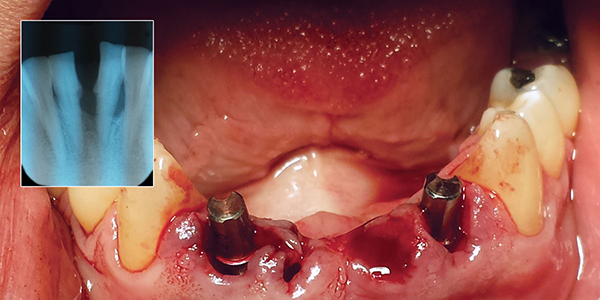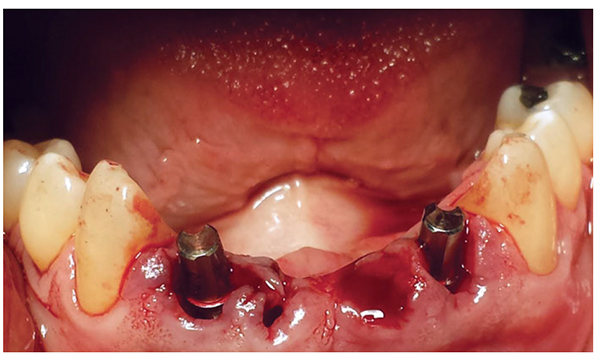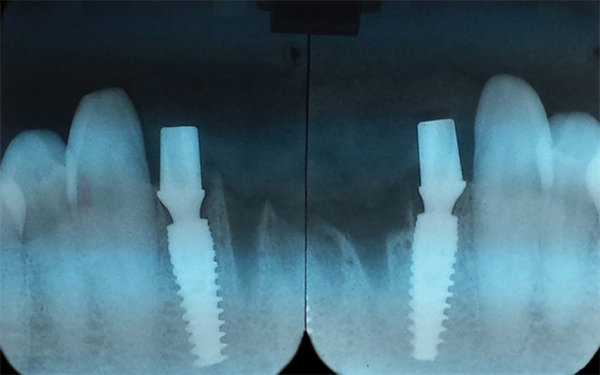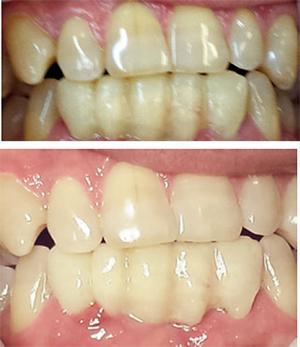Dr. M. John Matos discusses an immediate placement technique to produce a desirable outcome

Introduction
Immediate placement can produce esthetic and functional comfort,1 while also preserving the width and height of the alveolar bone and providing a patient with a reduction in treatment time and expense. The following case demonstrates the preferred outcome to multiple tooth extractions using the immediate placement and loading technique.
[userloggedin]
Patient presentation

A 49-year-old male presented to the office with obvious advanced periodontal issues that were limited to the mandibular anterior teeth. The teeth were no longer functional due to increased mobility, significant flare, and patient discomfort. The patient had a medical history of atrial fibrillation, a knee arthroscopy without complications, hypertension, and hyperlipidemia. The patient had no known drug allergies and was taking sotalol, diltiazem, pravastatin, and lisinopril.
Following the evaluation of the periradicular radiograph, the clinical recommendation was to extract teeth Nos. 23 through 26 and place two dental implants with a prosthesis (Figure 1).
Surgical treatment
At the surgical appointment, the patient received 2% lidocaine with epinephrine 1:100,000 units — total of 9.0 mL. After local anesthesia was administered, the lower incisors (Nos. 23 through 26) were extracted carefully to maintain alveolar bone; no subperiosteal flaps were elevated.
After extraction of the teeth, aggressive and meticulous curettage of the hard and soft tissues was required around the surgical site.2 The most serious osseous defect was in the tooth No. 24 area. The osteotomies were prepared, and it was noted that the vascularity of the extraction sockets were excellent, but the relative density of the bone was not expected in the para-symphysis.3 Using copious amounts of irrigation, the osteotomies were drilled to prepare for implant placement.4 Due to the density of the bone, implants featuring an aggressive thread design (Neodent® CM Drive) were chosen to provide the necessary torque and primary stability to enable immediate loading of the prosthesis.5 The inserted implants gained 60 Ncm insertion torque, which is acceptable for the immediate loading of dental implants. The implants were placed 2 mm subcrestally6 (Figure 2).


Prefabricated abutments were selected to minimize the impact on the adjacent hard tissues but also aid in the support of the adjacent soft tissues (Figure 3).
Chairside temporary restorations were fabricated, and the temporary prosthesis/stent because of subgingival margins acts as a support to the soft tissues, maintaining or even creating the interdental papilla.7 In coordination with the patient and his esthetic demands, the decision was made to create a five-tooth provisional for better esthetics.
The patient was given post-surgical instructions to eliminate incising with the anterior teeth for 6 weeks and included the use of penicillin VK 500 mg QID #40, Motrin® 600 mg QID #40, and Norco 10/325 mg #40 1 or 2 po q4-6h prn for pain.

At 7 days, the post-op response in the soft tissue was excellent (Figure 4).
At 28 days, it is easy to appreciate the maintenance and creation of the papilla “effect” in the tooth Nos. 25-26 papilla area (Figure 5).
At the 3-month mark, there are excellent soft tissue maturity and a healthy band of keratinized tissue (Figure 6).
Removal of the temporary also reveals mature tissues and good soft tissue collars around the abutments, which may be changed as needed, for optimized form, function, and hygiene.8
At the 5-month mark, the abutments used at the time of surgery were not changed, but rotated for more ideal positioning in preparation for the fabrication of a final prosthesis (Figure 7).
The soft tissue collars around the abutments were allowed to mature for 4 weeks, and the patient returned for final impressions. The soft tissue around the abutments proved to be quite resilient; retraction of the “sulcular” soft tissue was very difficult.9 Various options were discussed with the patient, and it was decided to impress to the base of the natural sulcus since the retention/stability of the temporary prosthesis was excellent. The patient consented, understanding that in the future should there be any compromise to form, function, or hygiene, the prosthesis may need to be changed out.



The prosthesis was delivered with a knife-edge collar design with the intent of not violating the soft tissue that matured around the abutment since the time of placement and then rotation10 (Figure 8).
The patient was very pleased with all aspects of treatment and the final outcome and content with the design in both form and occlusion (function). The soft tissues are beautiful in their color, contour, and surface/keratinization — there is maintenance of the bone and excellent “fill” in the defect that was seen in the area of tooth No. 24 during extraction (Figure 9).
[/userloggedin]
[userloggedout][/userloggedout]
- Wöhrle PS . Single-tooth replacement in the aesthetic zone with immediate provisionalization: fourteen consecutive case reports. Pract Periodontics Aesthet Dent. 1998; 10(9):1107-1114.
- da Rosa Jc, Rosa AC, Fadanelli MA, Sotto-Maior BS. Immediate implant placement, reconstruction of compromised sockets, and repair of gingival recession with a triple graft from the maxillary tuberosity: a variation of the immediate dentoalveolar restoration technique. J Prosthet Dent. 2014;112(4):717-722.
- Möhlhenrich SC, Modabber A, Steiner T, Mitchell DA, Hölzle F. Heat generation and drill wear during dental implant site preparation: systematic review. Br J Oral Maxillofac Surg. 2015;Jun 4 epub ahead of print. doi: 10.1016/j.bjoms.2015.05.004.
- Bullon B, Bueno EF, Herrero M, Fernandez-Palacin A, Rios JV, Bullon P, Gil FJ. Effect of irrigation and stainless steel drills on dental implant bed heat generation. J Mater Sci Mater Med. 2015;26(2):75.
- Javed F, Ahmed HB, Crespi R, and Romanos GE. Role of primary stability for successful osseointegration of dental implants: Factors of influence and evaluation. Interv Med Appl Sci. 2013;5(4):162–167.
- Castro DS, Araujo MA, Benfatti CA, Araujo Cdos R, Piattelli A, Perrotti V, Iezzi G. Comparative histological and histomorphometrical evaluation of marginal bone resorption around external hexagon and Morse cone implants: an experimental study in dogs. Implant Dent. 2014;23(3):270-276.
- Moy PK, Parminter PE. Chairside preparation of provisional restorations. J Oral Maxillofac Surg. 2005;63(9 Suppl 2):80-88.
- Palacci P, Nowzari H. Soft tissue enhancement around dental implants. Periodontol 2000. 2008; 47:113–132.
- Phatale S, Marawar PP, Byakod G, Lagdive SB, Kalburge JV. Effect of retraction materials on gingival health: A histopathological study. J Indian Soc Periodontol. 2010;14(1): 35–39.
- DeHoff PH, Anusavice KJ. Effect of metal design on marginal distortion of metal-ceramic crowns. J Dent Res.1984;63(11):1327-1331.
Stay Relevant With Implant Practice US
Join our email list for CE courses and webinars, articles and mores


